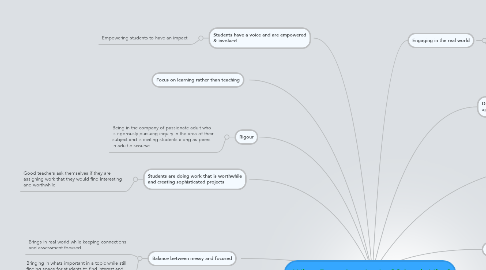What Does Inquiry in SS Look Like?
by Alanna Ehnes

1. Focus on learning rather than teaching
2. Rigour
2.1. Being in the company of passionate adult who is rigorously pursuing inquiry in the area of their subject and is inviting students along as peers in adult discourse
3. Students are doing work that is worthwhile and creating sophisticated projects
3.1. Good teachers ask themselves if they are assigning work that they would find interesting and worthwhile
4. Balance between messy and focused
4.1. Brings in real world while keeping connections and assessment focused
4.2. Bringing in whats important in a topic while still finding space for students to find interest and have a voice
5. Topics are sold to students
5.1. Gets them hooked and invested
6. Students have a voice and are empowered & involved
6.1. Empowering students to have an impact
7. Critical Thinking
7.1. Weigh evidence
7.2. Identify bias
7.3. Determine perspective
8. More than simply memorizing facts
9. Through Line Thinking
9.1. Asks provocative and relevant questions that encourage teachers and students to make connections to the 3 S's -Self -Subject matter -Society
10. Engaging in the real world
10.1. Connecting curriculum to outside world
10.2. Taking learning outside of school
11. Disposition towards the topic; The way you approach and think about it
12. Follows the Galileo Rubric
12.1. Authenticity **
12.2. Academic Rigor **
12.3. Assessment
12.4. Life Skills
12.5. Appropriate Use of Technology
12.6. Active Explortation
12.7. Connecting with Experts
12.8. Elaborated Communication
12.9. Compassion
13. Students are "being like" and "behaving like" the discliple (ex: behaving like a scientist)
13.1. Trying on new roles
13.2. More than studying about it; doing it and being it
13.3. Kids are learning to think, act and behave in the ways of the discipline
14. Goes beyond activity mania
14.1. Driving questions that connect to deeper issues
14.2. Student work goes beyond the typical teacher-student relationship
15. Produce things that add value to community
15.1. Active citizenship
16. Benchmarks of Historical Thinking
16.1. Historical Significance
16.2. Primary Sources as Evidence
16.3. Continuity and Change
16.4. Cause and Consequence
16.5. Historical Perspective
16.6. Ethical Dimensions of History
17. Leads to Dangerous Thinking
17.1. Engages students in often unasked questions
17.2. Critiques society and their school institution
17.3. Getting involving in change; Having a voice


